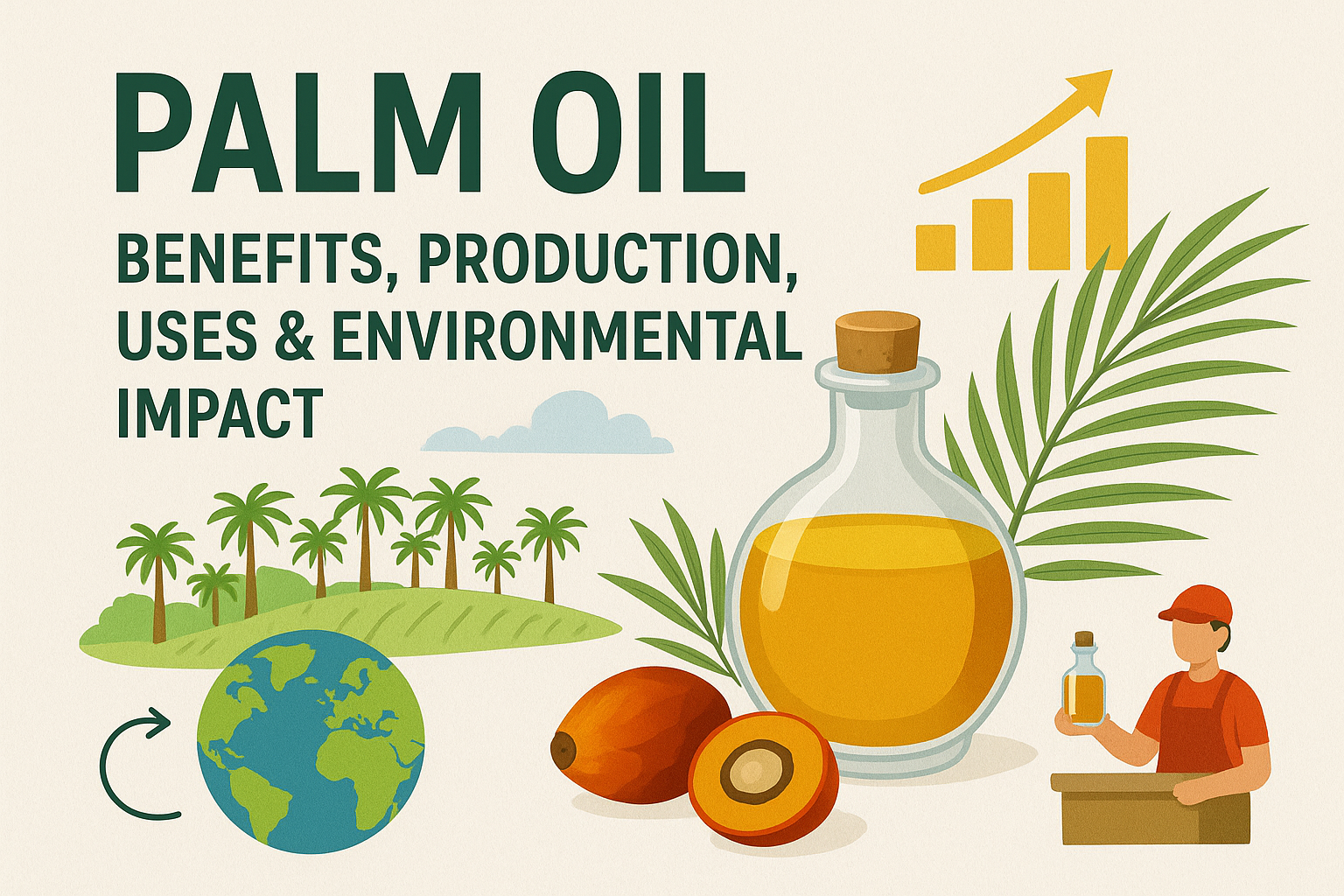Introduction
Palm oil is one of the most widely used edible oils in the world, extracted from the fruit of the oil palm tree (Elaeis guineensis). It is found in nearly half of all packaged products available in supermarkets — from food items like biscuits, margarine, and instant noodles to personal care products like soap, shampoo, and cosmetics. Due to its versatility, efficiency in production, and cost-effectiveness, palm oil has become an essential ingredient in the global economy.
The oil palm tree thrives in tropical climates, particularly in regions close to the equator. Its ability to yield a high amount of oil per hectare compared to other oil crops like soybean or sunflower makes it a preferred choice for large-scale cultivation. However, this popularity also brings several environmental and ethical challenges, including deforestation, habitat loss, and sustainability concerns.
History and Origin of Palm Oil
The use of palm oil dates back over 5,000 years. Archaeological evidence shows that it was used in ancient Egypt, with traces found in burial tombs dating as far back as 3000 BCE. The oil palm tree is native to West Africa, particularly in areas that are now Nigeria, Ghana, and Cameroon. In these regions, palm oil was used traditionally for cooking, medicine, and ceremonial purposes.
During the 15th and 16th centuries, European traders were introduced to palm oil through African trade networks. By the 19th century, palm oil became a significant export commodity, primarily used in industrial applications such as candle-making and soap production during the Industrial Revolution. Eventually, the oil palm tree was introduced to Southeast Asia — especially Malaysia and Indonesia — where it found an ideal environment for large-scale cultivation.

Palm Oil Production Process
Palm oil is derived from the fruit of the oil palm tree. The process involves several key stages, from harvesting to refining. Here’s a step-by-step overview:
- 1. Cultivation: Oil palm trees grow in tropical climates and take about 3–4 years to bear fruit. They produce large clusters of reddish-orange fruit, known as fresh fruit bunches (FFB).
- 2. Harvesting: Once the FFBs ripen, they are harvested manually or mechanically. The timing of harvest is crucial to ensure optimal oil yield and quality.
- 3. Sterilization: The harvested bunches are steamed under high pressure to loosen the fruits and deactivate enzymes that can spoil the oil.
- 4. Threshing: Fruits are separated from the bunches mechanically in this stage.
- 5. Pressing: The fruits are crushed to extract crude palm oil (CPO). The oil is then clarified to remove impurities.
- 6. Refining: Crude palm oil is further refined to produce edible palm oil. The refining process removes free fatty acids, color, and odor, making it suitable for food and other applications.
The production process is highly efficient — both palm oil (from the pulp) and palm kernel oil (from the seed inside the fruit) can be extracted, making it one of the most productive oil crops globally.
By-products and Waste Management
Besides the oil itself, several valuable by-products emerge from palm oil production. Palm kernel cake, a by-product of the extraction process, is used as animal feed due to its high protein content. Meanwhile, empty fruit bunches and palm fiber residues are often utilized as organic fertilizers or biomass fuel to generate energy within palm oil mills.
Sustainable producers are increasingly adopting waste recycling methods, such as converting palm oil mill effluent (POME) into biogas, to reduce pollution and enhance energy efficiency.
Major Palm Oil Producing Countries
The palm oil industry is globally concentrated in a few tropical countries that provide ideal growing conditions for oil palm trees. Among these, Indonesia and Malaysia dominate the global production, together contributing nearly 85–90% of the world’s total palm oil supply. However, several other countries in Asia, Africa, and Latin America are emerging as significant producers.
- Indonesia: The world’s largest producer and exporter of palm oil. Its favorable climate, government incentives, and vast land area have made it a leader in palm oil cultivation. The industry plays a critical role in Indonesia’s economy, employing millions of people directly and indirectly.
- Malaysia: The second-largest producer globally, Malaysia has a well-established and technologically advanced palm oil sector. It is known for sustainable plantation management and pioneering research in palm oil breeding and processing.
- Thailand: The third-largest producer, contributing to both domestic use and exports. Thailand’s palm oil production is mainly driven by smallholders.
- Nigeria: The largest producer in Africa and one of the oldest regions to cultivate oil palms. Despite having a strong traditional base, Nigeria’s output is relatively low due to small-scale farming and limited modernization.
- Colombia and Ecuador: Latin American countries are increasingly investing in palm oil as a major agricultural export, focusing on sustainability and biofuel applications.
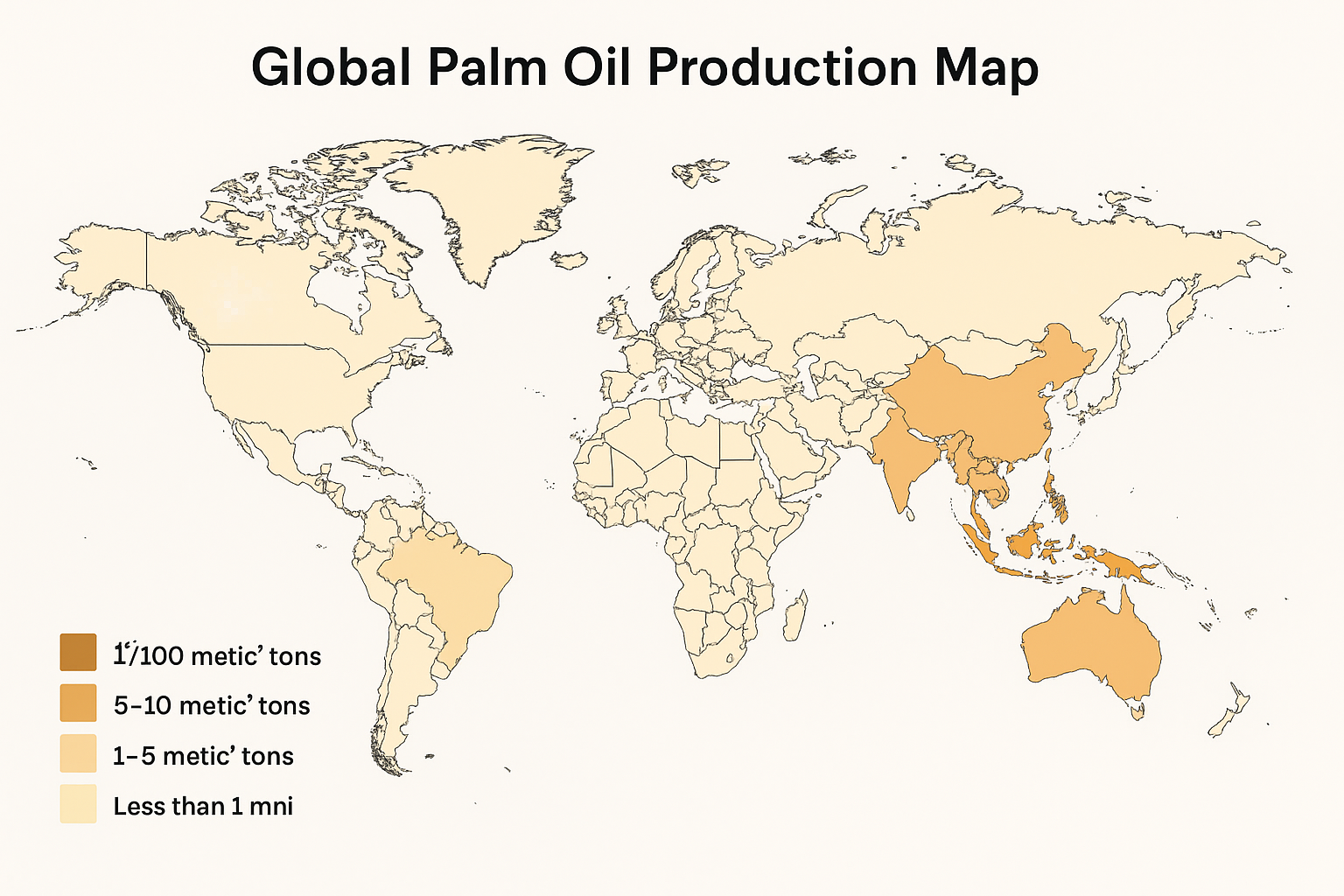
Uses and Applications of Palm Oil
Palm oil’s versatility is one of the main reasons for its massive global demand. It is a major ingredient in food, cosmetics, cleaning products, and biofuels. Due to its stability at high temperatures and smooth texture, it serves a wide range of industrial and domestic purposes.
1. Food Industry
Palm oil is extensively used as a cooking and frying oil due to its stability and long shelf life. It is also used in margarine, ice cream, bakery fats, confectioneries, instant noodles, and ready-to-eat snacks. Refined palm oil gives food products a desirable texture and flavor while being trans-fat free, which makes it a healthier alternative to partially hydrogenated oils.
2. Cosmetic and Personal Care Products
Palm oil and its derivatives (like palm kernel oil and palm stearin) are common ingredients in soaps, shampoos, lotions, and cosmetics. They act as moisturizers, emulsifiers, and texture enhancers. The natural vitamin E content (tocotrienols and tocopherols) also adds antioxidant benefits to these products.
3. Industrial and Biofuel Applications
Palm oil plays a growing role in the biofuel sector. With the global shift toward renewable energy, palm oil-based biodiesel is gaining prominence, especially in countries like Indonesia, Malaysia, and parts of the European Union. Palm oil is also used in lubricants, candles, detergents, and surfactants.
4. Pharmaceutical and Nutritional Uses
Owing to its high content of carotenoids and antioxidants, unrefined red palm oil is sometimes used as a nutritional supplement. It is rich in vitamins A and E, which support eye health and boost immunity.
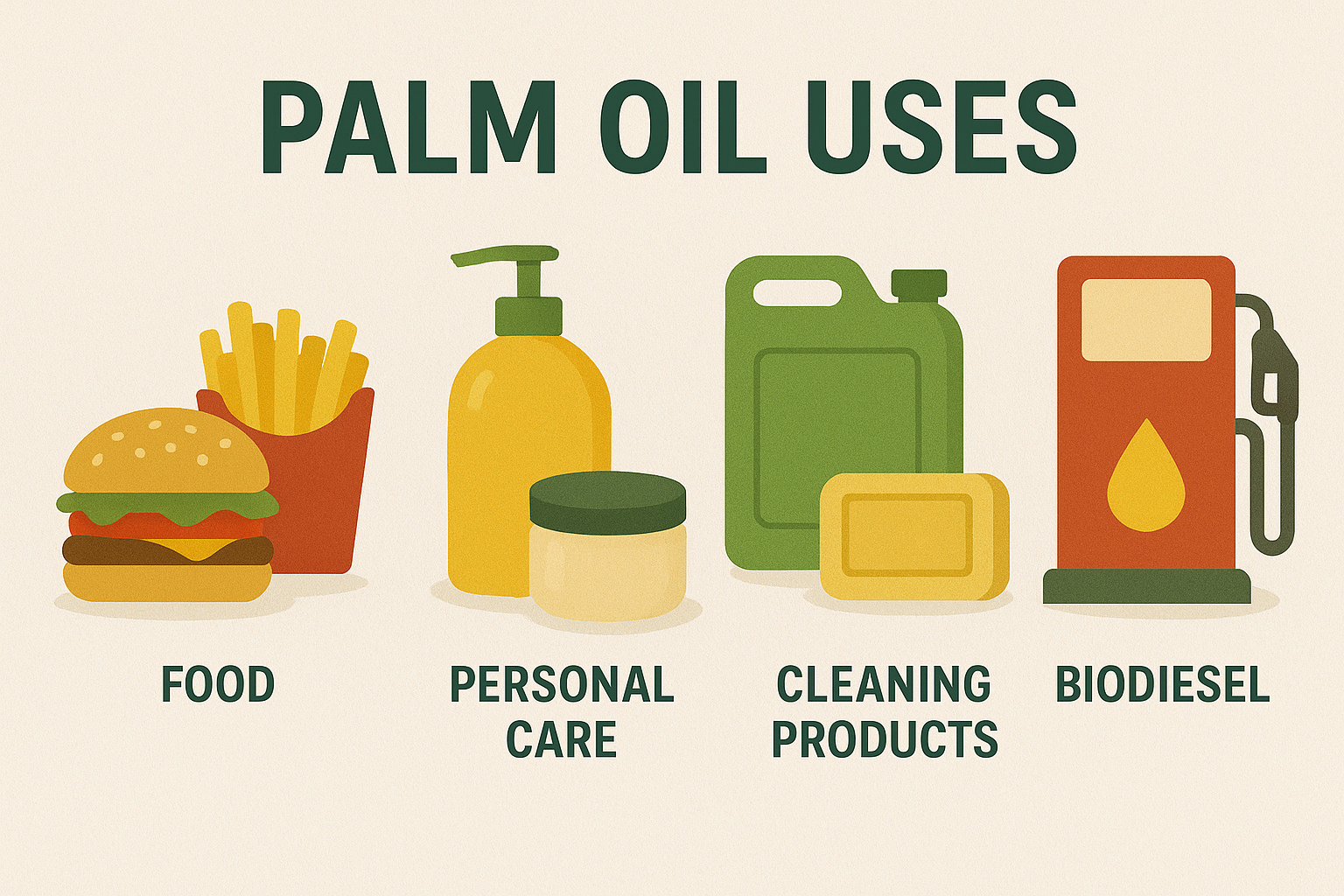
Economic Importance of Palm Oil
The palm oil industry contributes significantly to the economies of producing countries. It is a major source of foreign exchange, employment, and rural development. Millions of smallholder farmers depend on palm oil for their livelihood, especially in Southeast Asia and Africa.
Globally, the palm oil trade is valued at over USD 60 billion annually. The oil’s high yield (compared to other crops) means that it requires less land to produce the same amount of oil, making it a cost-efficient agricultural product. This economic advantage encourages developing nations to expand cultivation despite environmental challenges.
Many governments also rely on palm oil as a strategic resource to strengthen their renewable energy goals. Blending palm-based biodiesel with conventional fuels helps reduce dependency on fossil fuels and supports sustainable energy policies.
Palm Oil and Global Trade
The major importers of palm oil include India, China, the European Union, and Pakistan. These regions use it for food production, manufacturing, and energy. India, in particular, is the largest importer, using palm oil primarily for edible purposes due to its affordability compared to other vegetable oils.
The economic benefits of palm oil are undeniable, but they come with complex challenges — especially regarding environmental sustainability, land rights, and ethical sourcing. Balancing growth with ecological responsibility is now a global priority for the industry.
Environmental Impact of Palm Oil Production
While palm oil is an efficient and versatile crop, its rapid expansion has raised serious environmental concerns. Large-scale deforestation, habitat loss, and greenhouse gas emissions are among the most pressing issues associated with palm oil cultivation. These problems have drawn attention from environmental organizations, governments, and consumers worldwide.
1. Deforestation and Habitat Loss
To meet global demand, vast areas of tropical forests have been cleared for oil palm plantations — particularly in Indonesia and Malaysia. This deforestation destroys the natural habitats of endangered species such as orangutans, Sumatran tigers, and pygmy elephants. The reduction of forest cover also disrupts ecosystems, decreases biodiversity, and accelerates soil erosion.
2. Greenhouse Gas Emissions
Clearing forests for plantations often involves burning vegetation and draining peatlands. Peatlands, when disturbed, release massive amounts of carbon dioxide and methane — two potent greenhouse gases. As a result, palm oil cultivation contributes to global warming if not managed responsibly.
3. Water and Soil Pollution
Palm oil mills generate large volumes of waste, including Palm Oil Mill Effluent (POME), which can pollute nearby rivers and water bodies if discharged untreated. Excessive use of fertilizers and pesticides also contaminates the soil and groundwater, affecting surrounding communities and wildlife.
4. Land Conflicts and Social Issues
Expansion of plantations has led to conflicts over land ownership and indigenous rights. Many local communities rely on forests for their livelihood, and displacement caused by commercial plantations often leads to social and economic inequalities.
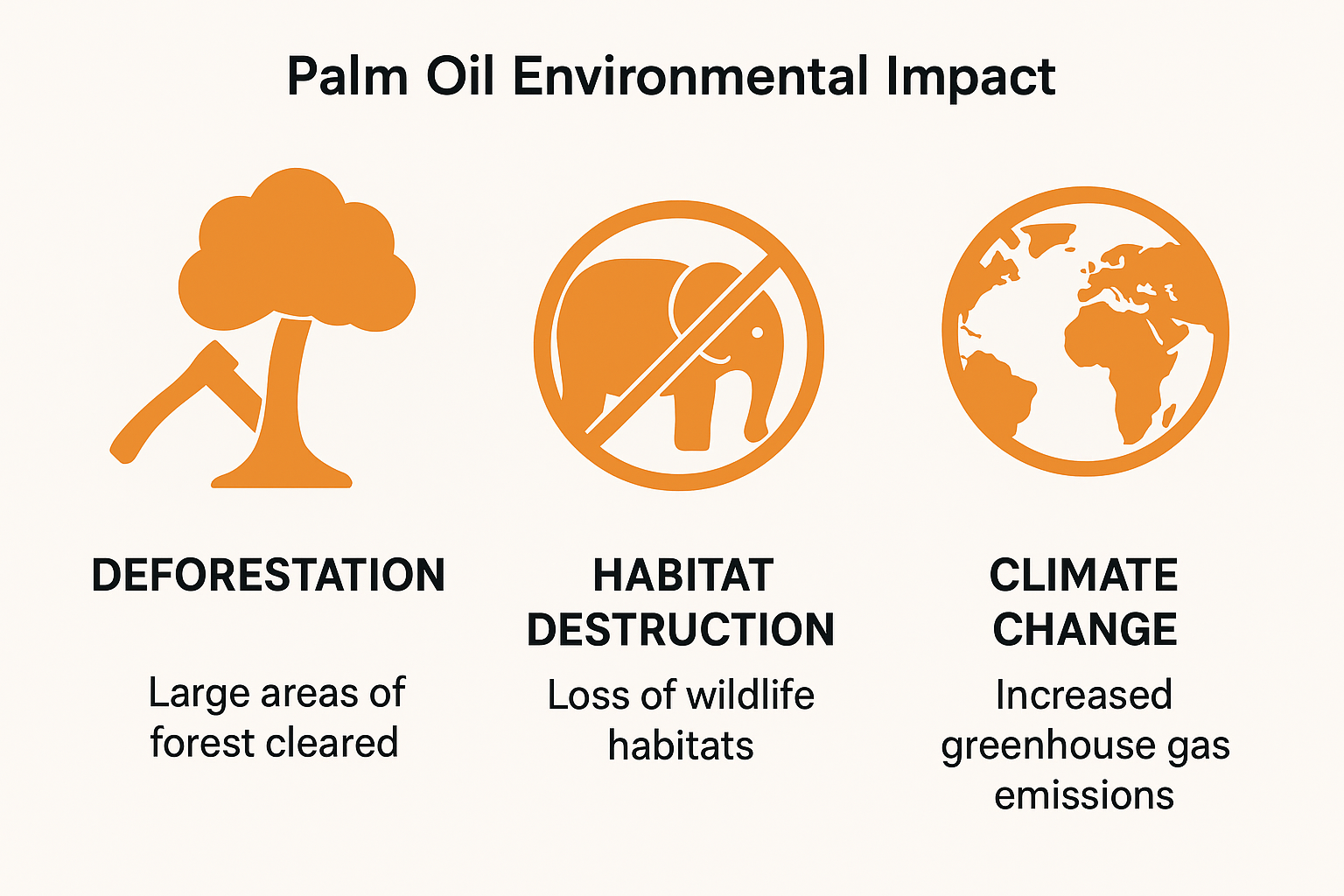
Health Aspects of Palm Oil
Palm oil is widely consumed as a cooking oil and food ingredient, making its health implications an important subject of research. It contains a balanced composition of saturated and unsaturated fats, along with vitamins and antioxidants.
1. Nutritional Benefits
Palm oil is rich in vitamin E (particularly tocotrienols) and carotenoids — compounds that have antioxidant properties and may help protect the body’s cells from damage. Red palm oil, which is minimally processed, retains more of these nutrients and is also a source of provitamin A (beta-carotene), which supports eye health and immune function.
2. Energy and Stability
Palm oil is a high-energy food that provides about 9 calories per gram. Its natural resistance to oxidation makes it stable during high-heat cooking and frying, unlike some other vegetable oils that produce harmful compounds when overheated.
3. Health Risks and Concerns
Despite its benefits, palm oil also contains a high proportion of saturated fats — around 50%. Excessive consumption of saturated fats has been linked to an increased risk of cardiovascular diseases. Moreover, during refining at high temperatures, palm oil can produce potentially harmful substances like 3-MCPD esters and glycidyl esters, which are under scrutiny for their possible health effects.
Therefore, while moderate consumption of high-quality palm oil can be part of a balanced diet, overconsumption and use of highly processed variants should be avoided. Public health experts recommend maintaining dietary diversity and focusing on unrefined or sustainably sourced oils.
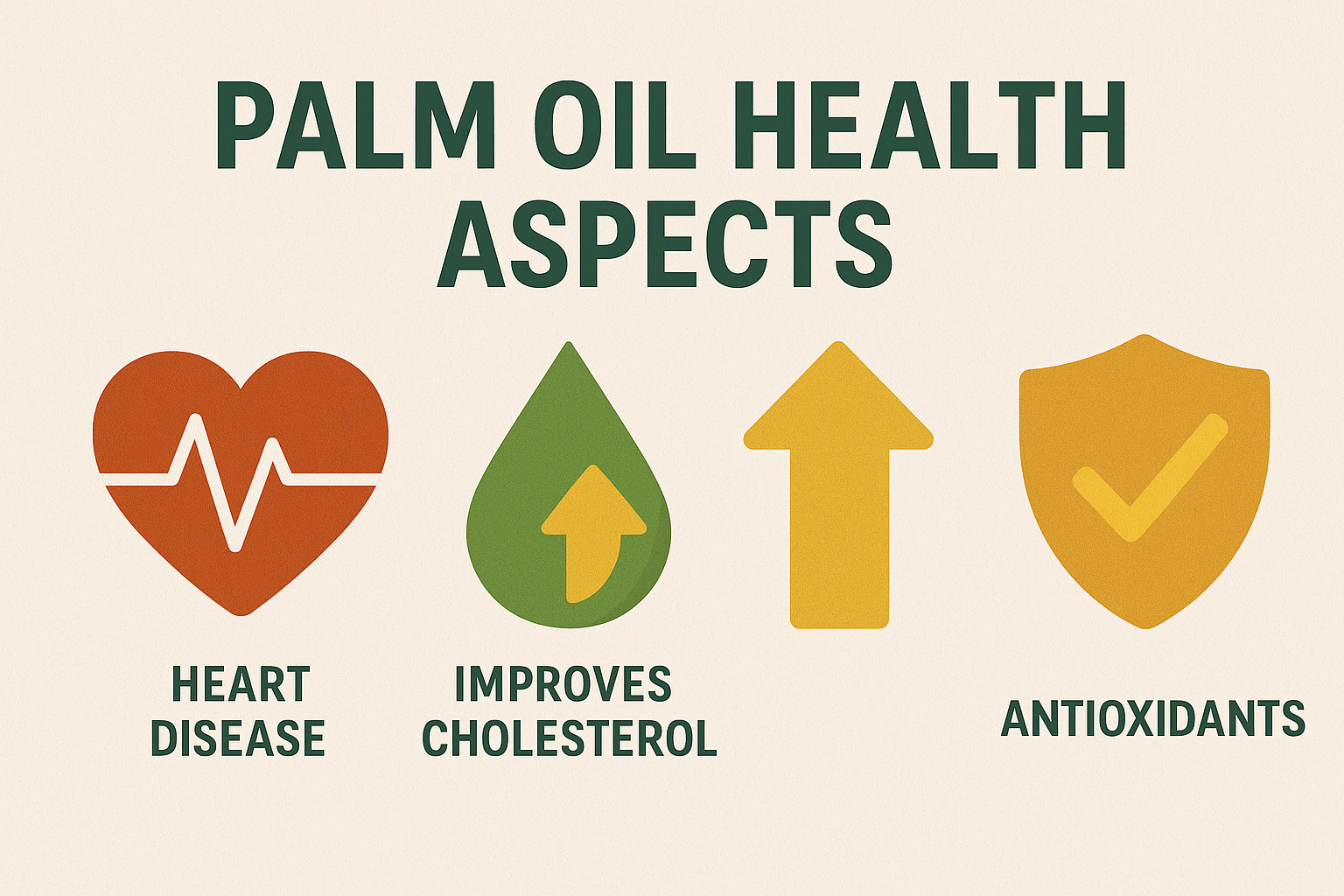
Sustainability Efforts in the Palm Oil Industry
To address the negative environmental and social impacts of palm oil production, numerous sustainability initiatives and certification programs have been introduced. These aim to promote responsible cultivation, reduce deforestation, and ensure fair treatment of workers and local communities.
1. Roundtable on Sustainable Palm Oil (RSPO)
The RSPO was established in 2004 to promote the growth and use of sustainable palm oil products. It sets environmental and social criteria for producers and ensures that certified companies minimize deforestation, protect biodiversity, and respect human rights. RSPO-certified palm oil is now widely used by major global brands.
2. Government and Corporate Commitments
Many countries, especially Malaysia and Indonesia, have introduced national sustainability standards like MSPO (Malaysian Sustainable Palm Oil) and ISPO (Indonesian Sustainable Palm Oil). These frameworks promote eco-friendly practices and encourage producers to adhere to international guidelines.
Global corporations, including food and cosmetic giants, are also pledging to source 100% certified sustainable palm oil (CSPO). This transition supports responsible supply chains and pressures producers to improve transparency.
3. Technological Innovations and Research
Advances in agricultural technology are helping to improve yields while reducing the need for new land. Techniques like precision agriculture, waste recycling, and biogas generation from palm residues are becoming more common. Research into genetic improvement of oil palm trees is also helping to create more productive and disease-resistant varieties.
While progress has been made, sustainable palm oil still represents only a portion of the total market. Increased consumer awareness, government policies, and international cooperation are essential to make sustainability the global norm rather than the exception.
Global Palm Oil Market Trends
The palm oil market has evolved significantly over the past few decades, becoming one of the most traded agricultural commodities in the world. Global demand continues to grow steadily due to its affordability, versatility, and wide range of applications in food, cosmetics, and energy sectors.
1. Market Growth and Demand
According to recent reports, global palm oil production exceeds 75 million metric tons annually, with demand rising in both developing and developed nations. The Asia-Pacific region, especially countries like India, China, and Indonesia, accounts for a significant share of consumption. Palm oil’s role as an affordable edible oil has made it essential in meeting food security needs for billions of people.
Besides food, the growing interest in renewable energy and biofuels has contributed to the expansion of palm oil use. As countries strive to meet carbon reduction targets, biodiesel derived from palm oil is being promoted as a renewable energy source, though its environmental implications remain under review.
2. Price Fluctuations and Trade Policies
Palm oil prices are highly influenced by global supply-demand balance, weather conditions, geopolitical issues, and trade regulations. For instance, export taxes and import duties imposed by producing or consuming nations directly affect international prices. Droughts or excessive rainfall caused by climate change also impact yields and lead to volatility in global markets.
Furthermore, global debates about deforestation-free supply chains have led to stricter import requirements, especially from the European Union. These regulations are designed to encourage sustainable sourcing but have also created new challenges for small-scale farmers and exporters.
3. Consumer Awareness and Ethical Sourcing
In recent years, consumers have become more conscious about the environmental and ethical impact of the products they buy. As a result, companies are increasingly labeling products with “RSPO Certified Sustainable Palm Oil” or other sustainability tags. Awareness campaigns by NGOs and environmental groups have also played a role in educating consumers about responsible choices.
This shift toward ethical consumption has prompted industries to re-evaluate their supply chains, leading to better traceability, transparency, and accountability within the palm oil sector.
The Future of the Palm Oil Industry
The future of palm oil will depend heavily on how well the industry adapts to sustainability standards, technological innovation, and climate change challenges. While palm oil remains a key contributor to global agriculture, its growth must align with environmental protection and social responsibility.
1. Technological Advancements
Research and innovation will play a critical role in shaping the next phase of the palm oil industry. Scientists are developing high-yield, low-impact palm varieties that require less land while producing more oil. Additionally, satellite monitoring and AI-based mapping tools are being used to prevent illegal deforestation and ensure plantation transparency.
2. Sustainable Business Models
A major focus for the future is building circular economy models — where waste products from palm oil processing, such as empty fruit bunches and effluents, are converted into energy or organic fertilizers. These initiatives not only reduce waste but also minimize the industry’s overall carbon footprint.
3. Global Policy and Collaboration
The success of sustainable palm oil depends on cooperation between producing and consuming countries. Policymakers, corporations, and environmental organizations must work together to create fair and transparent trade systems that support both environmental conservation and economic growth.
Programs that assist smallholders with financial support, training, and access to sustainable farming technology will be crucial. These farmers make up a significant portion of global palm oil production and are vital to long-term sustainability goals.
Challenges Ahead
Despite the progress made, the palm oil industry still faces several challenges:
- Ensuring fair treatment and wages for plantation workers.
- Balancing economic development with forest conservation.
- Improving transparency in supply chains to avoid illegal logging.
- Combating misinformation and improving consumer education about palm oil’s pros and cons.
- Adapting to changing global trade regulations related to environmental compliance.
Addressing these issues will determine whether palm oil continues to be seen as a sustainable resource or a contributor to environmental degradation.
Conclusion
Palm oil stands at a crossroads — between its economic value and its environmental cost. It is undeniably one of the most productive oil crops in the world, offering livelihoods to millions and serving as a vital ingredient in global food and manufacturing industries. However, its production must evolve to meet the growing demands for sustainability and ethical responsibility.
Through innovations in agriculture, stronger sustainability certifications, and conscious consumer choices, palm oil can become a truly sustainable commodity. Governments, corporations, and individuals all share the responsibility to ensure that this valuable natural resource contributes to both human progress and environmental preservation.
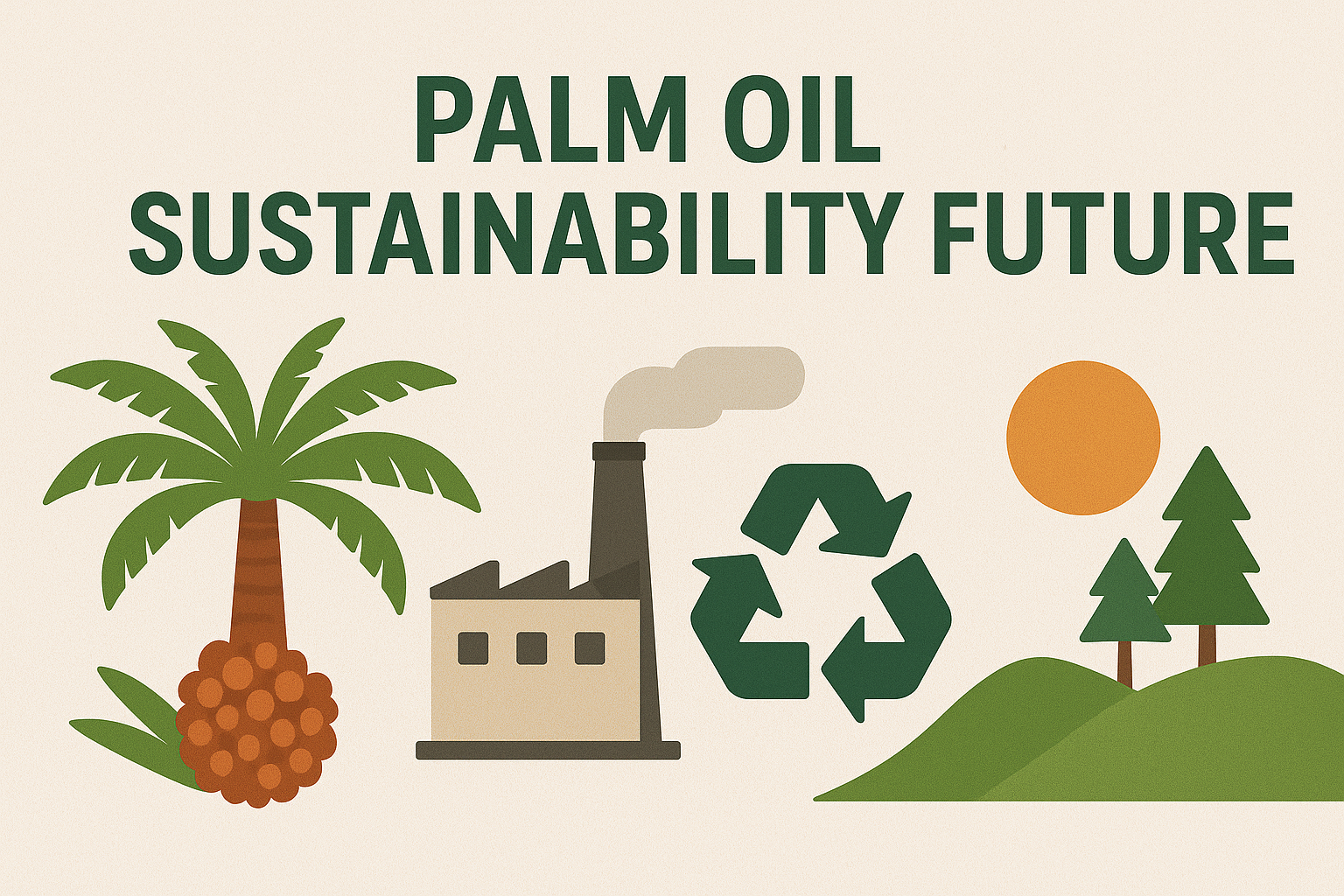
Written for educational and informational purposes by TheCubicals
